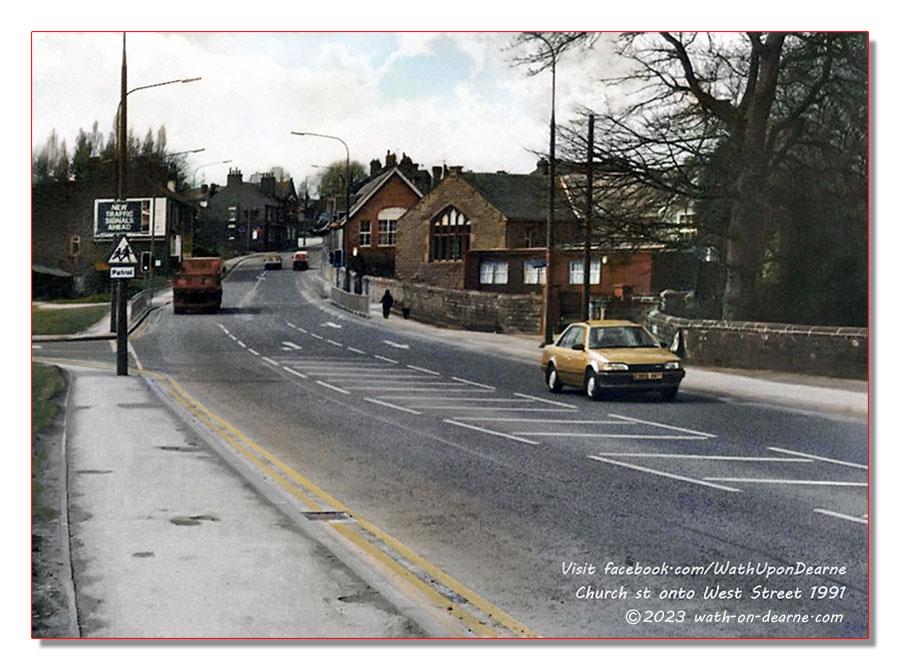 On a radiant morning in early spring, the year being 1991, Wath-upon-Dearne basked in the hopeful embrace of a weekend. A mustard-coloured saloon, its purpose twofold—either embarking on a zealous shopping spree or embarking upon a familial visit—ventured forth, perhaps with the intention of journeying to the nearby Mexborough, a mere four miles away, in order to catch a train at the station nestled within.
On a radiant morning in early spring, the year being 1991, Wath-upon-Dearne basked in the hopeful embrace of a weekend. A mustard-coloured saloon, its purpose twofold—either embarking on a zealous shopping spree or embarking upon a familial visit—ventured forth, perhaps with the intention of journeying to the nearby Mexborough, a mere four miles away, in order to catch a train at the station nestled within.
In the midst of this picturesque scene, halfway up on the right side, loomed the venerable edifice of Wath Church of England Junior School. It was here that a gentleman, bearing a striking resemblance to an individual named Albert, strolled purposefully with his faithful hound, seemingly wending their way homeward to the tranquil village of West Melton.
Across from the school, one’s gaze alighted upon a sentinel-like pedestrian patrol sign, positioned on the left corner at the base of Church Street. This was the spot where departing traffic would usually pause, yielding to the main road leading towards the bucolic paths that wove through West Melton, then onward to Wombwell and Stairfoot, a stone’s throw away from the bustling town of Barnsley.
As the sun’s golden rays cast their glow upon the landscape, a medium-sized scarlet builder’s truck toiled uphill, its destination not far from the famed George and Dragon Pub. This ale house was renowned for its flawless execution of a smooth, creamy hand-pulled pint of the ever-popular John Smith’s beer. The mere thought of such a resplendent amber liquid, adorned with a creamy, frothy crown, nestled atop a chilled glass, its foundation dutifully cushioned by a humble cardboard beer mat, bearing the vibrant colours of the magnet crest, held steadfast by a polished oak table, evoked visions of times gone by.
Indeed, this venerable establishment evoked an era when happiness and delight could be savoured without the exorbitant toll of 21st-century living—a period where the price of existence was not weighed solely by material possessions but rather encompassed the simplicity of neighbourly support for one another.
Oh, how the 21st century pales in comparison to the tranquillity depicted in this idyllic tableau! The sparse vehicular traffic that meandered along the roads in 1991 is a far cry from the clamour that dominates the present day. If one were to witness the same vista today, they would find traffic lights and pedestrian crossings, not erected for convenience, but rather to safeguard the lives of students en route to the school—a sanctuary against the relentless onslaught of air-polluted metallic armies, comprised of cars and trucks, vying to conquer the realm of commerce and profit, whether as employer or employee.
But the tranquil serenity would soon yield to the ebb and flow of life’s rhythm. In just a few hours, the streets would teem with parents and their offspring, embarking on their Monday morning pilgrimage to the hallowed halls of learning. The week’s commencement awaited, accompanied by the reassuring presence of dutiful guardians shepherding their charges along the path of knowledge.
Editors Comment:
The era depicted in this vivid narrative exudes a sense of nostalgic charm and simplicity, transporting readers to a time when life unfolded at a gentler pace. The author’s attention to detail and skilful use of descriptive language paint a vivid picture of the quaint English town, its inhabitants, and the cultural landscape of 1991. The contrast drawn between the tranquillity of the past and the frenetic pace of the present offers readers a poignant reflection on the toll of modern living. Overall, the author masterfully captures the essence of the era, evoking a wistful longing for a simpler time.